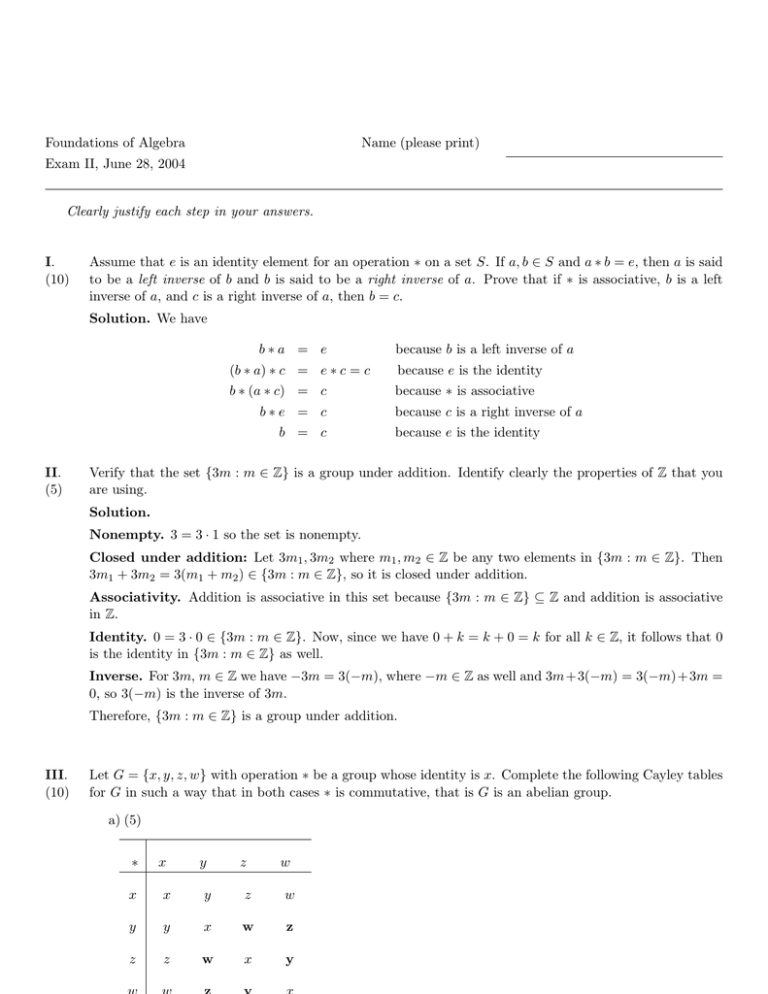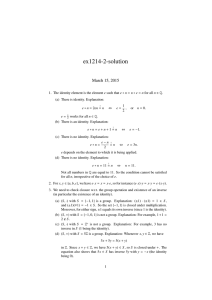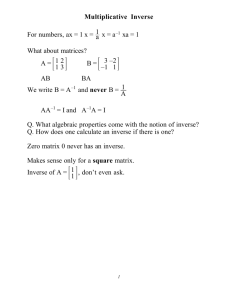Foundations of Algebra Name (please print) Exam II, June 28, 2004
advertisement

Foundations of Algebra
Name (please print)
Exam II, June 28, 2004
Clearly justify each step in your answers.
I.
(10)
Assume that e is an identity element for an operation ∗ on a set S. If a, b ∈ S and a ∗ b = e, then a is said
to be a left inverse of b and b is said to be a right inverse of a. Prove that if ∗ is associative, b is a left
inverse of a, and c is a right inverse of a, then b = c.
Solution. We have
b∗a = e
(b ∗ a) ∗ c = e ∗ c = c
because e is the identity
b ∗ (a ∗ c) = c
because ∗ is associative
b∗e = c
b = c
II.
(5)
because b is a left inverse of a
because c is a right inverse of a
because e is the identity
Verify that the set {3m : m ∈ Z} is a group under addition. Identify clearly the properties of Z that you
are using.
Solution.
Nonempty. 3 = 3 · 1 so the set is nonempty.
Closed under addition: Let 3m1 , 3m2 where m1 , m2 ∈ Z be any two elements in {3m : m ∈ Z}. Then
3m1 + 3m2 = 3(m1 + m2 ) ∈ {3m : m ∈ Z}, so it is closed under addition.
Associativity. Addition is associative in this set because {3m : m ∈ Z} ⊆ Z and addition is associative
in Z.
Identity. 0 = 3 · 0 ∈ {3m : m ∈ Z}. Now, since we have 0 + k = k + 0 = k for all k ∈ Z, it follows that 0
is the identity in {3m : m ∈ Z} as well.
Inverse. For 3m, m ∈ Z we have −3m = 3(−m), where −m ∈ Z as well and 3m+3(−m) = 3(−m)+3m =
0, so 3(−m) is the inverse of 3m.
Therefore, {3m : m ∈ Z} is a group under addition.
III.
(10)
Let G = {x, y, z, w} with operation ∗ be a group whose identity is x. Complete the following Cayley tables
for G in such a way that in both cases ∗ is commutative, that is G is an abelian group.
a) (5)
∗
x
y
z
w
x
x
y
z
w
y
y
x
w
z
z
z
w
x
y
Page 2
b) (5)
∗
IV.
(10)
x
y
z
w
x
x
y
z
w
y
y
z
w
x
z
z
w
x
y
w
w
x
y
z
Write each of the following as a single cycle or a product of disjoint cycles (each part is worth 5 points):
a) (1 2 3)−1 (2 3)(1 2 3) = (1 3 2)(2 3)(1 2
Since (1 2 3)−1 = (1 3 2)
Or, using the two-row form representation of cycles:
−1
1 2 3
2 3 1
3) = (1
2)
1 2 3 1 2 3 1 2 3 1 2 3 1 2 3 1 2 3
◦
=
◦
◦
=
◦
1 3 2
2 3 1
3 1 2
1 3 2
2 3 1
2 1 3
b) (2 4 5)(1 3 5 4)(1 2 5) = (1 4)(2 5 3)
Or, using the two-row form representation of cycles:
1 2 3 4 5 1 2 3 4 5 1 2 3 4 5 1 2 3 4 5 1 2 3 4 5
=
◦
◦
◦
4 2 3 1 5
1 5 2 4 3
3 2 5 1 4
2 5 3 4 1
1 4 3 5 2
V.
(10)
Let S = {1, 2, 3, 4} and G = S4 . Let T be a subset of S and write GT for the subgroup of G consisting of
the permutations α ∈ G such that α(t) = t for each t ∈ T . Find GT for the following choices of T .
a) (5) T = {1, 4}
GT = {(1), (2 3)}
b) (5) T = {2, 3, 4}
GT = {(1)}
Page 3
VI.
(5)
Name (please print)
Verify that the set {α1,b : b ∈ R} is a subgroup (for the operation of composition of mappings) of the group
{αa,b : a, b ∈ R a 6= 0}, where the mapping αa,b : R → R is defined for x ∈ R by αa,b (x) = ax + b.
Solution.
Nonempty. Since α1,0 , given by α1,0 (x) = x for x ∈ R is in the set, it is nonempty.
Closed under composition. For x ∈ R we have α1,b ◦α1,c (x) = α1,b (x+c) = x+c+b, so α1,b ◦α1,c = α1,b+c .
Thus, {α1,b : b ∈ R} is closed under composition.
Inverse. If α1,b ∈ {α1,b : b ∈ R} then α1,−b ∈ {α1,b : b ∈ R} as well since b ∈ R implies −b ∈ R. We have,
for each x ∈ R, α1,b ◦ α1,−b (x) = α1,b (x − b) = x + b − b = x = α1,−b ◦ α1,b (x). Thus α1,−b is the inverse of
α1,b .







